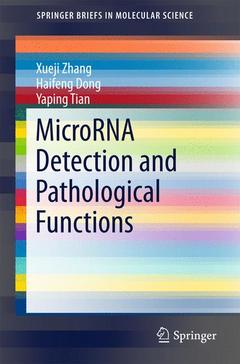Description
MicroRNA Detection and Pathological Functions, 2015
SpringerBriefs in Molecular Science Series
Authors: Zhang Xueji, Dong Haifeng, Tian Yaping
Language: English
Subjects for MicroRNA Detection and Pathological Functions:
52.74 €
In Print (Delivery period: 15 days).
Add to cart101 p. · 15.5x23.5 cm · Paperback
Description
/li>Contents
/li>Biography
/li>Comment
/li>
This book summarizes microRNA (miRNA) biology in a variety of pathological processes, emphasizing the significant potential applications of miRNA in diagnostics and prognostics, as well as novel drug targets. The conventional techniques used for miRNA detection including standard PCR, Northern blotting, microarray and clone methods are addressed. Recent emerging strategies in miRNA detection and quantification with superior flexibility and adaptability, such as novel molecular biological techniques and locked nucleic acid (LNA) modified probes, as well as nanotechnology-based approaches, are also included. The book also highlights the latest advances in clinical-related miRNA detection methods in living cells, circulating blood and tissue, such as in situ hybridization (ISH) and molecular imaging techniques, which are useful to elucidate the biogenesis and biological function of miRNAs in vivo. Finally, the respective advantages and drawbacks of various detection techniques in this fast-moving field are discussed, along with the challenges and promising new directions.
This book offers a valuable resource for analytical chemists, biologists and physicians involved in miRNA research.
Dr. Xueji Zhang and Dr. Haifeng Dong are Professors at the School of Chemistry & Biological Engineering, University of Science & Technology Beijing (USTB), China.
Dr. Yaping Tian is a Professor at the Department of Clinical Biochemistry, Chinese PLA General Hospital and Military Medical School, China.
Dr. Xueji Zhang is a Professor and the Dean at the School of Chemistry & Biological Engineering, University of Science & Technology Beijing (USTB), P.R. China. He received his BSc. and Ph.D. from Wuhan University in 1989 and 1994, respectively. His postdoctoral work was completed at National Institute of Chemistry, Slovenia, Swiss Federal Institute of Technology, Zurich and New Mexico State University, Last Cruces, USA from 1995-1999. He has been a Research Scientist, Sr. Scientist, Chief Scientist, Vice President and Sr. Vice President at World Precision Instruments, Inc. USA until 2010, when he joined USTB as National Chair Professor under “Chinese 1000 Elites Program”. His research interests span the disciplines of chemistry, biology, materials and medicine with an emphasis on the studies of biosensing, biomedicine and bioenergy. His lab focuses on the development of novel biosensors, tools and devices to study free radicals, cancer biomarkers, profiling changes in animal or human associated with diseases and exploit this information for development of diagnostic and therapeutic approaches. In addition, his group investigates drug delivery, new energy and natural medicines. He serves as the chief editor of Am. J. of Biomed. Sci. and has been an editorial member of 17 international journals. He has received numerous national and international awards and honors including Member of Russian Academy of Engineering, Fellow of Royal Society and Simon Fellow of ICSC-World Lab. He has authored ~300 papers, 5 books and holds 43 patents. He has developed numerous sensors and instruments for commercialization.
Dr. Haifeng Dong received his B.S. and M.S. degrees from Three Gorge University in 2005 and Chongqing University in 2008, respectively. Under the supervision of Professor Huangxian Ju, he received his Ph.D. degree from Nanjing University in 2011. He joined the group of Professor Xueji Zhang at the University of Science & Technology
5). These papers have beProvides a comprehensive summary of current techniques for miRNA detection
Describes both the technical and clinical aspects of miRNA
Addresses the promising clinical applications of miRNA, emphasizing their practicality and utility in clinic diagnostics and therapy
Includes supplementary material: sn.pub/extras
These books may interest you

MicroRNA Targeted Cancer Therapy 158.24 €

MicroRNA Targeted Cancer Therapy 158.24 €


